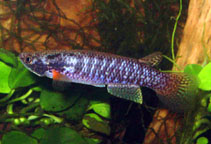| Family: |
Rivulidae (Rivulines), subfamily: Kryptolebiatinae |
| Max. size: |
6.51 cm TL (male/unsexed) |
| Environment: |
benthopelagic; freshwater |
| Distribution: |
South America: Tapanahony River drainage in Surinam. |
| Diagnosis: |
Differs from other Kryptolebias and Rivulus species by a combination of characters including low number of lateral line scales, high number of anal rays, short predorsal length and a robust body, and unique mitochondrial DNA gene sequences. Kryptolebias sepia differs further by remarkably strong melanistic pigmentation and the ability to change this coloration into several distinct patterns, lack of obvious sexual dimorphism, strong dichromatism between juveniles and adults, and absence of the Rivulus spot in females and juveniles (Ref. 53862). |
| Biology: |
Found only in primary forests with a very dense canopy cover and appears to inhabits only extremely shallow parts of small creeks in hilly areas. Occurs outside the main stream in swampy areas directly adjacent to creeks. |
| IUCN Red List Status: |
Not Evaluated (N.E.) Ref. (130435)
|
| Threat to humans: |
harmless |
Source and more info: www.fishbase.org. For personal, classroom, and other internal use only. Not for publication.

